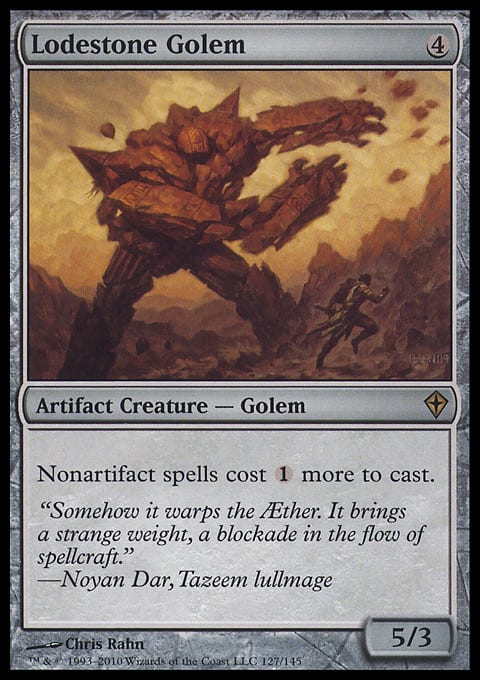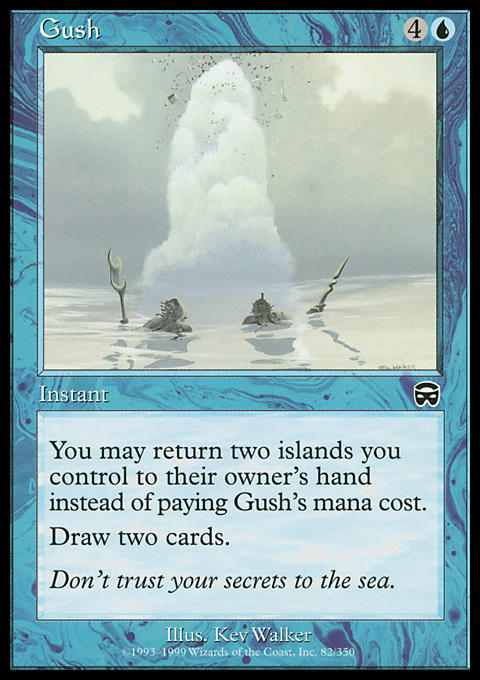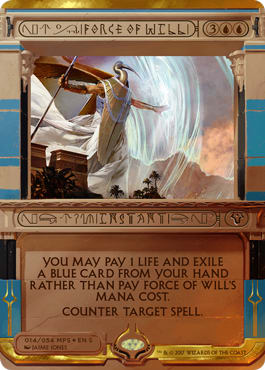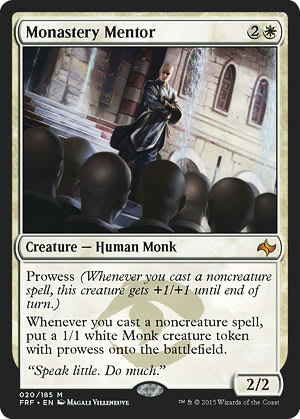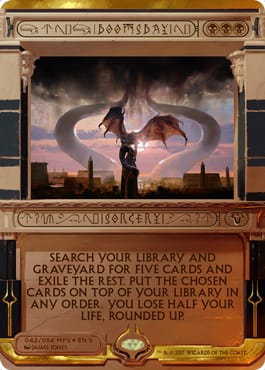My prediction that Mishra's Workshop decks would still be around following Lodestone Golem’s restriction in April has so far turned out to be mostly false. The Magic Online Power 9 Challenge, held at the end of April, had sixty players. Four of them played Workshops (including Eldrazi and Martello versions, which have Kuldotha Forgemaster); twenty-seven others played Gush—mostly Mentor, but also some U/R Delver and Grixis Pyromancer. People complained when Shops were around 30% of the metagame, and Gush was 45% here. I will acknowledge that Workshops and Storm had the highest win percentages (at 55% and 59%, respectively), but it’s considerably less frightening when they’re near the bottom of popularity.
It is also worth noting that, in the eight matches played between Shops and Gush in that event, Shops won six of them. Sphere effects, it seems, are still good against Gushes, even without Lodestone Golem.
Vintage right now is dominated by blue decks. It has been a joke or complaint about the format in the past—that everyone plays the same blue cards, starting with the restricted list and ending with whatever finisher they want—but it’s truer now than it has been in the past. Everyone wants to draw cards and counter spells. I admit that can be pretty fun, but if that’s not your thing (or you don’t want to play mirror matches), it can become old quickly.
It will be interesting to see what Wizards of the Coast decides about the metagame if it doesn’t adjust soon. Workshops help keep blue decks “honest,” so without many artifacts in the metagame, blue decks tend to evolve to fight each other, which is where we are now. The easy solution would be to restrict Gush, but there are a couple of problems there: First, it might not balance the environment, and second, we end up with three newly restricted cards (Chalice of the Void, Lodestone Golem, and Gush), whereas zero might be sufficient.
Vintage can adjust to its environment because there are answers to every problem in the history of Magic, and changes come even faster now because of Magic Online. It’s likely that Workshop mages haven’t found their roles in a world without Lodestone Golem since a lot of easy wins were taken away and some previous ideas about the deck will have to be unlearned. Wizards may also need to continue tweaking, and the format might be “saved” by an upcoming printing (who knows?), but there were more playable strategies last year at this time.
When in Mercadia . . .
So, Gush is a great card. It’s a card that most players can look at and immediately see the benefit: In a game in which cards represent power, you gain more cards—for free! As with most spells, though, getting the best out of Gush isn’t quite as simple. Picking up two lands can be a huge drawback since it sets you back on mana in play and potentially prevents you from casting higher-cost spells until much later turns. It’s also self-limiting in that way; you run out of lands to Gush quickly, ending up ahead on cards but behind on other resources, such as mana in play.
With that, here are a few things to note:
Along with the two cards, Gush frequently serves as a makeshift mana source. With two Islands in play on turn three, you can tap them, float mana, return the lands with Gush, and replay one of them to have to 3 mana, without ever having or drawing a third land. Reaching 3 mana is particularly important now when most decks are using Monastery Mentor as a win condition.
This property also allows Gush-based decks with additional cantrips to cut lands in favor of more business spells. The origins of this strategy go back to 1997 Miracle-Gro decks, developed by Alan Comer with cheap creatures, cheap cantrips, Gush, Land Grant, Force of Will, Daze, and ten lands. They look surprisingly like Vintage decks.
The “rule” allowing decks to trade lands for cantrips was developed by Comer for an earlier deck, Turbo-Xerox, and inscribed by Mike Flores:
The principle of the original Xerox deck is that for every four 1- or 2-mana cantrips, you can remove two lands. Therefore, even though Alan played only seventeen actual Islands, the Foreshadows, Impulses, and Portents raised his effective count considerably. In the early game, Alan would have to use his cantrips to find lands, but in the late game, he could use them to always have a counter in hand.
Looking at modern Vintage decks (this example is from a U/R/w Pyromancer–Delver list), the idea still holds. Gush-based blue decks often have a collection of cards like:
- 4 Preordain
- 4 Gush
- 2 Gitaxian Probe
- 2 Jace, Vryn's Prodigy
- 1 Brainstorm
- 1 Ponder
- 1 Ancestral Recall
- 1 Time Walk
Those are sixteen cantrips (not including later-game spells like Treasure Cruise and Dig Through Time), which should equate to a whopping eight lands cut. Added to the deck’s eighteen main-decked mana sources, we effectively have twenty-six mana, a more than respectable total for a control deck. “Extra” mana also allows lands like Strip Mine to sacrifice and function as spells rather than mana.
Later in the game, once the mana is available, cantrips and draw spells turn into business: counterspells, removal, and creatures. That is, early draw helps you get in the game and establish yourself; later draw spells let you keep that advantage so you can finish strong. Force of Will is particularly important in this part of the game, and Gush-based decks are very good at both finding Force of Will and paying its alternate cost.
Because of its role in replaying lands, Gush is also a main-phase play rather than an end-of-turn one. This is contrary to most instants, where the idea would be to run them out on your opponent’s end step, forcing the player to react then and leaving a clearer path for sorcery-speed actions on your turn.
Main-phase Gush maximizes your mana and is an important bait or support spell for sorcery-speed plays. For example, even though it only draws two cards, an opponent might counter a Gush and become vulnerable for a follow-up Yawgmoth's Will or Monastery Mentor. If the player lets Gush resolve, you might draw an additional counter or discard spell. For this reason, it’s often better to Gush into more mana than your real goal requires—for example, Gush into 4 mana for Monastery Mentor so you have additional mana to counter with. You can always use that mana afterward to play Preordain or another cantrip to trigger Mentor.
When you float mana, it’s also important to consider what colors you want. Most of the time, it’s easy enough to take 2 blue. And, of course, it’s easy enough to go with whatever spells you have in hand and will want to play afterward, but what if you draw a better option (usually something like Vampiric Tutor or Demonic Tutor)? What if you return a Tundra and an Underground Sea and end up wanting to play Monastery Mentor and Thoughtseize? Do you want to tutor for Fastbond in a four-color list? Is there a Tendrils of Agony in your opponent’s future and you need an extra black mana now? Often, you can save yourself by replaying whatever dual land you need, but it does pay to consider potential options.
Last for this section, don’t forget that Gush has a payable casting cost. It’s easy enough to cast for 5 mana, especially if your deck has all the Moxes or includes Sol Ring or Mana Crypt. People joke about hard-casting Gush (and Force of Will) like it’s shameful, but it is, in fact, totally reasonable. And since it straight-up draws two cards, it’s very much on the line of counterable or not. If you pay mana for Gush and it resolves, great—if not, no big loss. Hard-casting Gush makes it a great end-of-turn play, too, so just be aware that your opponent might take the opportunity to do stuff if you tap out.
That sums up most of Gush’s basic uses: It acts as a mana source early and a filter late; it’s better at sorcery speed; it’s good as bait and as a backup; it lets you fix colors; and it still has a casting cost. There are some corner-case options, too.
Gush can “rescue” a land from land destruction uncounterably. Since returning two lands is paid as a cost, it can’t be responded to. I would warn against using Gush against Wasteland, though. In the right situation, Gushing a land targeted by Wasteland can be amazing; you draw two cards and save a land, and your opponent sacrifices a land for nothing. However, returning two lands against a mana-denial deck can also be devastating to your own game, setting you back two turns and giving your opponent an opportunity to punish you further with more mana denial or permanent-based attacks like Tangle Wire. The alternative—that is, letting the land become Wasted—is a parity play; you and your opponent both lose something. Against a lot of Wasteland decks, I’ll take Gushes out for games two and three.
As a free draw spell and mana producer, Gush is great in all kinds of storm combo decks (partly because its alternative cost remains playable under Yawgmoth's Will), because it can draw from top-deck tutors like Mystical Tutors and Vampiric Tutors for free. It is for this reason Gush is a great addition to Doomsday decks in Vintage over those in Legacy.
Take, for example, this recent Top 8 list from Jerry Yang, who loves when I share his decks:
Doomsday Oath ? Vintage | Jerry Yang
- Creatures (1)
- 1 Laboratory Maniac
- Spells (44)
- 1 Ancestral Recall
- 1 Brainstorm
- 1 Dark Ritual
- 1 Dig Through Time
- 1 Hurkyl's Recall
- 1 Mystical Tutor
- 1 Vampiric Tutor
- 3 Flusterstorm
- 4 Force of Will
- 4 Gush
- 4 Mental Misstep
- 1 Demonic Tutor
- 1 Duress
- 1 Gitaxian Probe
- 1 Merchant Scroll
- 1 Ponder
- 1 Thoughtseize
- 1 Time Walk
- 1 Treasure Cruise
- 4 Doomsday
- 4 Preordain
- 1 Fastbond
- 1 Black Lotus
- 1 Lotus Petal
- 1 Mox Jet
- 1 Mox Sapphire
- 1 Sensei's Divining Top
- Lands (15)
- 3 Island
- 2 Tropical Island
- 3 Misty Rainforest
- 3 Polluted Delta
- 4 Underground Sea
- Sideboard (15)
- 4 Forbidden Orchard
- 4 Oath of Druids
- 3 Hurkyl's Recall
- 1 Blazing Archon
- 1 Memory's Journey
- 1 Tendrils of Agony
- 1 Yawgmoth's Will
This list plays as a typical Laboratory Maniac combo Doomsday list in the main deck, but it can add Oath of Druids (including Blazing Archon) versus Workshop and creature-based decks or supplement the Doomsday and combo options with Yawgmoth's Will and Tendrils of Agony if it appears LabMan will be difficult to protect. A more typical Doomsday list (without the transformational ’board) would look similar to the one Stephen Menendian is playing in this season of the Vintage Super League.
Gush, Black Lotus, and Ancestral Recall are huge boons for Vintage Doomsday players. Paired with Doomsday, Gush can help secure the 2 black mana you need, or it can draw into your Doomsday pile for free and provide additional mana to win right away. Obviously, Lotus and Ancestral Recall are just the best mana source and card-draw in the game.
The typical “easy” Doomsday pile is to resolve Doomsday on and make the top-to-bottom stack of Ancestral Recall, Black Lotus, Laboratory Maniac, Mox Sapphire, and Gitaxian Probe. Gush into Ancestral Recall and Lotus, Ancestral Recall into the rest of your deck, play LabMan, and Probe for the win. Of course, there are one-draw and 1-mana piles, similar to those played in Legacy, but Gush being free and worth two cards allows more flexible piles that include protection or disruption (for example, freeing up a mana to Duress a Sudden Shock).
Last, don’t forget that Gush returns Islands to your hand. This can be valuable in odd situations. For example, Merfolk will sometimes try to islandwalk over with Lord of Atlantis and friends, and Gush can act as a combat trick to set up blocks. Likewise, Massacre is a potential card against Monastery Mentor, and Gush (if played in advance—it won’t help once Massacre is cast) can help stop the alternate cost by taking Tundras off the board.
Actually, I’ll add a codicil here about Fastbond. The 1-drop enchantment that complements Gush so well has fallen out of favor recently. First, I think the reason is Mental Misstep, and second, the reason is it pushed Gush decks to add a color against particularly aggressive Workshop mana-denial decks. The current metagame might favor adding Fastbond (and the extra color, if necessary), as the matchup between two similar blue decks often favors the one that’s more aggressive with colors, mana, and bombs. Fastbond and Gush can combine to do some ridiculous things.
Gush is so much more than draw two cards. It’s even more than draw two “free” cards. Learning the ins and outs of Gush and how it works differently in different situations is critical to winning in the current Vintage metagame.
Thanks for reading!
Nat Moes
















